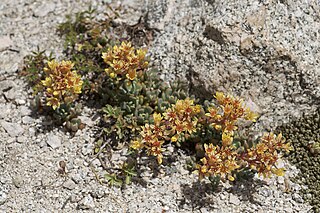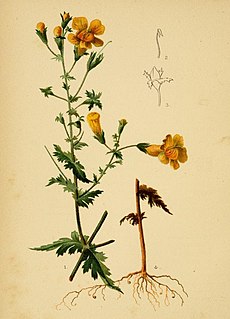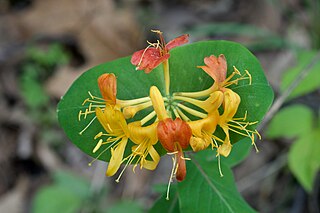
Cornus florida, the flowering dogwood, is a species of flowering tree in the family Cornaceae native to eastern North America and northern Mexico. An endemic population once spanned from southernmost coastal Maine south to northern Florida and west to the Mississippi River. The tree is commonly planted as an ornamental in residential and public areas because of its showy bracts and interesting bark structure.

Cardamine hirsuta, commonly called hairy bittercress, is an annual or biennial species of plant in the family Brassicaceae, and is edible as a salad green. It is common in moist areas around the world.

Packera obovata, commonly known as roundleaf ragwort, spoon-leaved ragwort, roundleaf groundsel, or squaw-weed, is an erect perennial herb in the Asteraceae (aster) family native to eastern North America. It was previously called Senecio obovatus. Basal and lower leaves are obovate with toothed margins, while upper leaves are pinnately divided. The ray flowers are yellow and the disk flowers orange-yellow, the inflorescences being held well above the foliage.

Thalictrum thalictroides, synonym Anemonella thalictroides, the rue-anemone, is a herbaceous perennial plant native to woodland in eastern North America. It has white or pink flowers surrounded by a whorl of leaflets, and it blooms in spring.

Liatris pycnostachya, the prairie blazing star, cattail gayfeather or cattail blazing star, is a perennial plant in the Asteraceae family that is native to the tallgrass prairies of the central United States.

Symphyotrichum laeve is a flowering plant native to Canada, the United States, and Coahuila (Mexico). It has the common names of smooth blue aster, smooth aster, smooth-leaved aster, glaucous Michaelmas-daisy and glaucous aster.

Potentilla gracilis, known as slender cinquefoil or graceful cinquefoil, is a species of cinquefoil. It ranges from Alaska down the west coast of Canada and the United States, and Colorado.

Sambucus racemosa is a species of elderberry known by the common names red elderberry and red-berried elder.

Potentilla recta, the sulphur cinquefoil or rough-fruited cinquefoil, is a species of cinquefoil. It is native to Eurasia but it is present in North America as an introduced species, ranging through almost the entire continent except the northernmost part of Canada and Alaska.

Sedum obtusatum is a species of flowering plant in the family Crassulaceae known by the common name Sierra stonecrop. It is native to the Sierra Nevada and adjacent high mountain ranges of California, its distribution extending north into Oregon and east into Nevada. It grows in rocky mountain habitat.

Senna italica, the Port Royal senna, Italian senna, or Senegal senna is a legume tree in the genus Senna. It is recognized by many other common names based on the regions it grows in. In India, it is used to produce a powder for treating hair-related diseases which is known as “neutral henna”. Whereas, in some parts of the world, this species is cultivated for the leaves which yield the drug senna, known commonly as Senna glycoside, which in turn is the base for a laxative. Senegal senna is easily distinguishable through its many distinctive features. There are 3 subspecies of this plant based on the size of the inflorescence and the length of the petiole. The subspecies are italica, micrantha, and arachoides. In many regions, this plant is cultivated commercially and medicinally.

Trollius laxus is a rare flowering plant species in the buttercup family, Ranunculaceae. It is native to North America and is considered to have two subspecies, one with a distribution is the east and one in the west. Common names for Trollius laxus include American globeflower and American spreading globeflower. The American Globeflower, Trollius laxus is an endangered species of flowering plants Native to Northeastern United States. This species of plants is limited in range by their ability to exclusively survive in wetlands and marshes. Thus, clusters of the species are constantly threatened by the ever-changing hydrology of the range they are confined to.

Rosa blanda, commonly known as the smooth rose, meadow/wild rose, or prairie rose, is a species of rose native to North America. Among roses, it is closest to come to a "thornless" rose, with just a few thorns at the base. The meadow rose occurs as a colony-forming shrub growing to 1 m (3.3 ft) high, naturally in prairies and meadows. The roses are quite variable, the characteristics such as leaf tip number of prickles and glandular hairs usually do not always remain constant, thus it is often confused with Rosa arkansana or Rosa carolina, the two other prairie rose species.

Helianthus decapetalus, known by the common names thinleaf sunflower and thin-leaved sunflower, is a perennial forb in the family Asteraceae. It is native to the Eastern and Central United States and Canada, from New Brunswick west to Iowa, Wisconsin, and Ontario, south as far as Georgia and Louisiana. It produces yellow composite flowers in late summer or early fall.

Balduina uniflora is a North American species of plants in the sunflower family. It is native to the southeastern United States. It is the type species of Genus Balduina.

Aureolaria pedicularia, the fernleaf yellow false foxglove, fern-leaved false foxglove, or fernleaf false foxglove, is a parasitic plant of the family Orobanchaceae. Aureolaria pedicularia is native to parts of the eastern US, the Midwest, and adjacent Canada. This plant is known for its distinct leaf shape and overall plant size. The common names for Aureolaria pedicularia come from its fern-like leaves.

Baptisia bracteata, otherwise known as longbract wild indigo, long-bract wild indigo, long-bracted wild indigo, plains wild indigo, cream false indigo, or cream wild indigo, is a perennial herbaceous plant in the Fabaceae (bean) family that is native to the central and eastern United States. It is one of the earliest blooming species of Baptisia, beginning to bloom in March in certain areas of the United States. The flower clusters (racemes) spread out sideways or sprawl across the ground, unlike most other Baptisia species, which have vertical racemes.

Verbena stricta, also known as hoary verbena or hoary vervain, is a small purple wildflower native to a large region of the central United States.

Ranunculus hispidus is a species of perennial flowering plant in the buttercup family, Ranunculaceae. It is commonly known as bristly buttercup or hispid buttercup. It is a small plant native to central and eastern North America that grows to a height up to 30 cm (1 ft) and has 5-petaled yellow flowers.

Lonicera flava is a species of honeysuckle native to the central and eastern United States. It is a woody vine with yellow-orange flowers that are slightly fragrant.





















